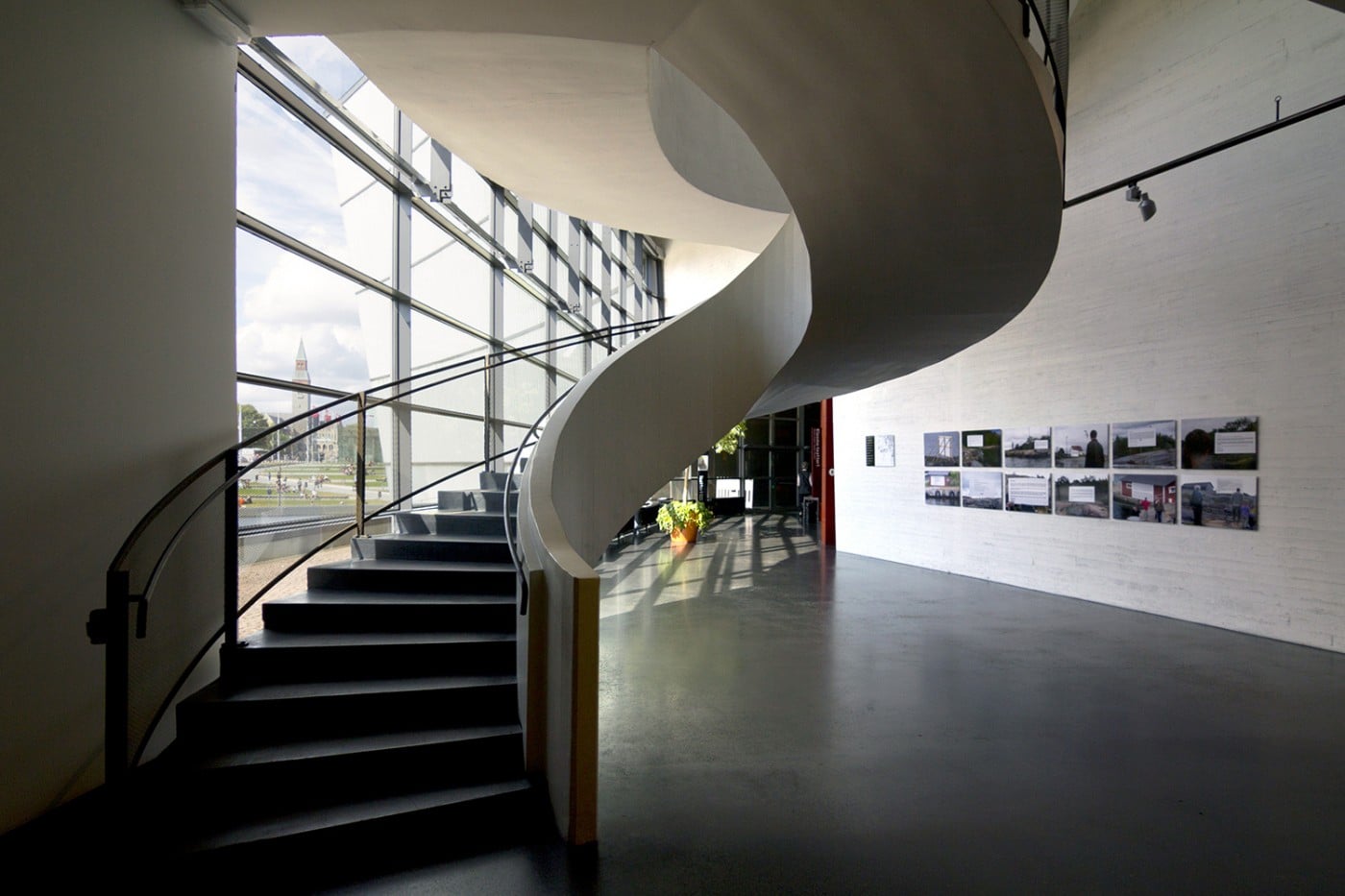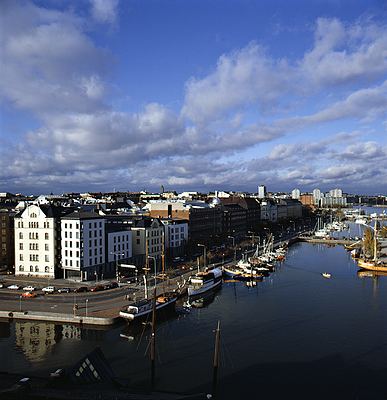
If you’re thinking of passing on Helsinki this winter as out of the way and too cold, you’re definitely not keeping your New Year’s resolution to be a more trend-setting traveler. In fact, you’re falling way behind the curve. Finland’s capital has been a design hothouse for longer than most of us have been on the planet and this year it’s more exciting than ever. Helsinki is happening, haven’t you heard?
In Finland, architects are revered, furniture is an obsession, and a new wool muffler or mobile phone is an agonizing choice. If this describes your idiosyncratic behavior, too, you owe it to yourself to visit Helsinki. Design pilgrims will thrill to the feeling that they’ve discovered an intense subculture. Finns are discreetly reticent. But they bask in their compatriots’ game-changing architecture, interior design, furniture, and fashion.
This year is a great time to go as Helsinki is the World Design Capital for 2012 and it’s an easy trip, too. Finnair flies nonstop from New York, Miami, Toronto, and about 50 European cities, awarding One World Alliance mileage (American Airlines).
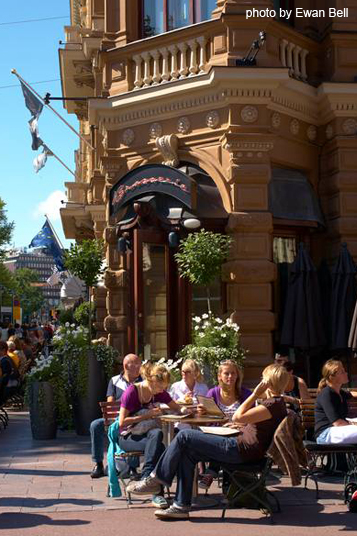
In spring and fall, Helsinki has a clear, cool, Baltic charm with a sky that is uniformly white, which acts almost like a photo studio’s seamless roll, spotlighting its memorable architecture. Summer is the best time to visit, naturally, when the days are long (close to 20 hours) and the humid continental climate brings comfortable temps averaging around 70 degrees. Bright sun and a prevalent café culture bring Helsinki residents out of doors and they take to the streets on these balmy days and long, lusty nights. Conversely, winter brings some darkness with it but temperatures are buffered thanks to the Baltic Sea and Gulf Stream and are much higher than the northern location would suggest with an average of about 25 degrees.
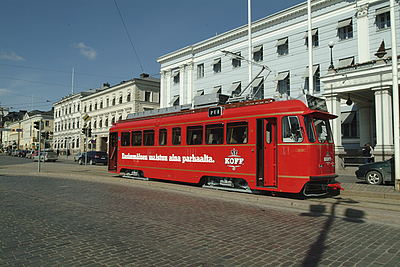
Helsinki’s taxi fares may be on par with London’s so if you’re feeling extravagant and have a set destination that’s not too far, jump in one. However, I suggest you pick up a Helsinki card which will entitle you to unlimited travel on public transport and prepare to hop a few of the eco-friendly, ever-present trams that weave their way throughout the city’s nooks and crannies. It’s the Euro way to run, don’t you know? Plus, much of Helsinki is walkable so put on those walking shoes for leisurely strolls along Mannerheimintie, the main drag.
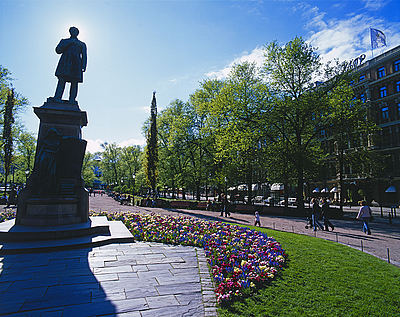
It’s a good idea to stay in the center on or near Esplanadikatu (Esplanadi), a broad boulevard with a lovely green park in its center, like Paris or Buenos Aires. Many of the main attractions are close-by and in good weather, locals hang out there, snacking, socializing, picnicking, and swigging from a taskumatti, a useful word here when your thoughts turn to partying – a flask. With the easygoing nature of the populace, it’s a cinch they will.
The Esplanadi is a good perch to survey Helsinki’s spectacular Art Nouveau, Art Deco, and Finnish Modern architectural heritage. Finland’s architects consistently broke new ground and this capital city is their temple. History happened here. A few minutes away by foot, Eliel Saarinen’s 1914 Helsinki Central Railway Station sets the tone for every monumental railroad station of the 20th century. Retail shrines to design dot the boulevard including ARTEK, a timeless home furnishings brand founded by Finnish architectural deity Alvar Aalto, Iittala , whose iconic product is a freeform glass vase designed by Aalto and Marimekko, the Mod, big-print 1960s fashion company currently reinvigorated by devout fashionistas like Sarah Jessica Parker.
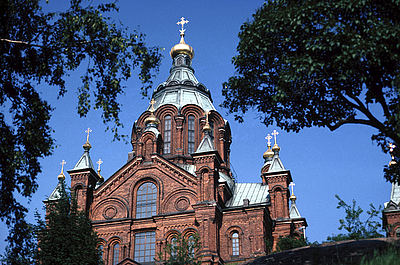
In Helsinki, design envelops you. Don’t miss the Design Museum which provides a crash course in all innovations Finnish. Its’ circa 1873 home — a storybook, multi-spired confection – is a striking contrast to the minimalist modernity within. Just east of the Esplanadi, Katajanokka, an island joined by a footbridge, proves a treasure trove of Art Nouveau (Jugend) architecture. You’ll be enchanted by charming, yellow-hued apartment houses and by Uspenski Cathedral, a Russian Orthodox masterpiece. Just down a hill from the cathedral is Alvar Alto’s sternly geometric, Lego-like headquarters of Enso-Gutzeit. This mining company evolved from the world’s first corporation, a copper mine that issued ownership shares in 1288.
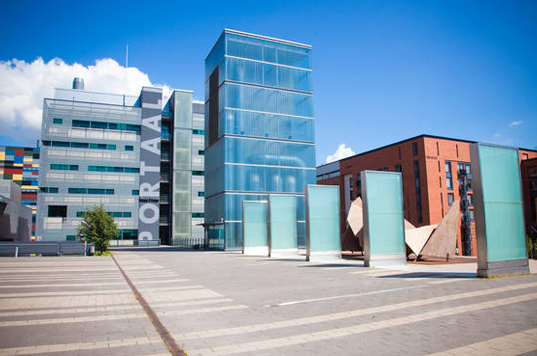
A prowl through Arabianranta, a design-oriented model community of apartments, offices, and shops, involves a train or bus ride well worth the undertaking. This “Art & Design City,” which houses The Aalto University School of Art & Design, will strike creative-spirited visitors as a utopia. (About the odd name: when the neighborhood was settled, it was considered far from downtown Helsinki, much like the landmark Dakota apartment building on New York’s Upper West Side where John Lennon and Yoko resided).
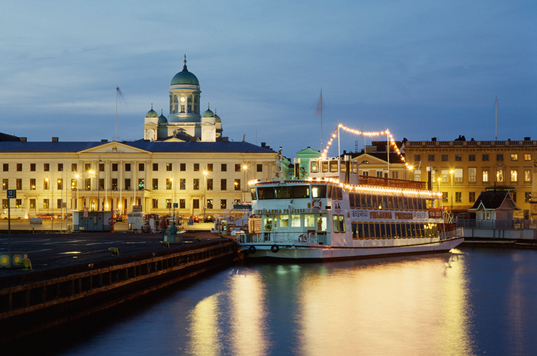
Who are these Finns, with their intricate language, their intuitive design sense, and their newly won independence (1917) from Russia? Visitors in search of the elusive Finnish soul will find clues at Stockmann, a landmark department store with the kind of psychic power that Macy’s Herald Square exerts on New York City. Elsewhere, department stores have been eclipsed by chic boutiques, state of the art mega-malls, and e-commerce. But Stockmann, still the letter of the land decrees and bags the Finnish lifestyle: fresh rye, wheat and potato bread, herring fifty ways, gaily packaged licorice candy, real paper books, Finnish housewares that put Sweden’s IKEA to shame and stylish, sturdy sweaters, parkas, and boots befitting the folks who invented the ice hotel. (A Finn once told me: “There’s no bad weather, only bad clothes.”)
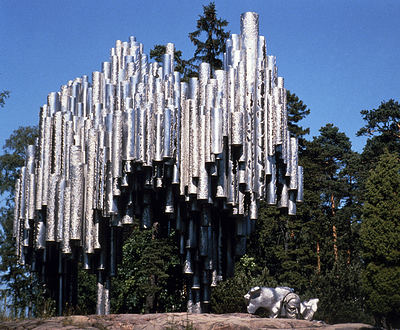
On a good weather day, join these hardy Finns in Hesperia Park in the heart of Helsinki as they stroll, dog-walk, and jog the path that circles Toolonlahti Bay. Finlandia Hall, a majestic, white marble concert hall designed by Aalto and the indisputable bastion for modern Finnish culture, lords it over this lofty setting. Its’ repertory celebrates Finland’s beloved composer Jean Sibelius, who set the national epic, Kalevala, to music. The tubular Sibelius Monument, unveiled in 1967, is just a stone’s throw away in the Toolo district’s Sibelius Park, a spectacular reminder that Finland’s design DNA is still breaking barriers and evolving even to today.
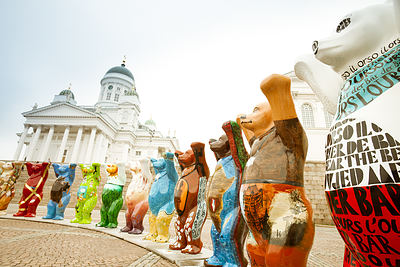
Dress well – remember, there are no bad clothes – and contemplate Helsinki, where culture, design, and the freewheeling Finnish soul all run free.
The international dialing code for Helsinki is 358.
[box bg=”#fbedd8″]A Primer for Understanding Helsinki’s Design DNA:
1912: Architect Eliel Saarinen’s soaring Helsinki Central Railway Station opens ushering in an era of glamorous rail departures and arrivals.
1935: Architect Alvar Aalto founds furniture design company Artek with partners. His organic materials and sinuous, spine-conforming wooden shapes change everything.
1936: Finnish glassware company Iittala introduces the Savoy Vase designed by Alvar Aalto for Savoy Restaurant, a head to toe Aalto project. The amorphous shape is said to resemble a Finnish lake. The “Aalto Vase” becomes a mid-century icon, now produced in a rainbow of colors and sizes.
1962: Eliel’s son, Eero Saarinen’s graceful, soaring TWA Terminal opens at New York’s Idlewild Airport (now JFK), doing for air travel what his father’s Helsinki train station did for rail.
1964: Helsinki clothing shop, Marimekko, known for its repurposed industrial cotton broadcloth, introduces its giant poppy print and rivets the fashion world. Today there are 84 Marimekko stores worldwide.
1971: Aalto’s Finlandia Hall opens. Its’ striking white marble contours and dramatic cobalt blue auditorium give Finland’s musical heritage a home worthy of Valhalla.
1982: Nokia, a Helsinki manufacturer of goods like rubber boots and electric cable, introduces the first mobile phone, the shoebox-sized Mobira Senator. Today Nokia is the world’s top-selling phone maker.
2009: The three young Finnish software engineers behind Helsinki game developer Rovio introduce Angry Birds, now the world’s most-downloaded mobile app.
2010: Ivana Helsinki, a free-spirited fashion line designed by Paola Ivana Suhonen, produces its first New York runway show, to general acclaim.
2012: Helsinki is declared World Design Capital for 2012 by the International Council of Societies of Industrial Design.
Where to Stay:
Hotel Klaus K – Helsinki’s chic-est boutique hotel, Klaus K was built in 1938 and reopened as a stylistically impeccable Design Hotel in 2005. Modern but not forbidding guest room décor echoes the themes of Finland’s epic poem, Kalevala – passion, desire, mysticism, and envy. In-house dining includes Toscanini for pasta and Ilmatar for modern Finnish cuisine. Ahjo nightclub – your move. Bulevardi 2, Helsinki. +358 (0) 20 770 4700. www.klauskhotel.com
Hotel Kamp – Finland’s only five-star hotel, The Kamp, is the Helsinki hotel name to drop. Built in 1887 and reopened in 1999, this elegant grande dame has 179 roomy, poshly traditional rooms and suites with decadent bathrooms that recall Roman spas. Guests feast like Romans, too, in the Kamp’s champagne focused bar, Yume sushi restaurant, and Kamp SIgné, a modern Finnish kitchen. The upscale Kamp Galleria mall backs the hotel. Kluuvikatu 2. +358 (0) 9 576 111. www.hotelkamp.com.
Hotel GLO Kluuvi – GLO Helsinki is owned by Hotel Kamp and shares its gym and spa. The GLO is a service-oriented, 144-room boutique hotel with perks like cameras and laptops to borrow, heated mattresses with massage features and Scandinavian gym equipment like a Nordic Walking Pole machine. GLO’s pizza-and-pasta eatery, lobby, and sidewalk café are intensely social. Kluuvikatu 4. +358 10 3444 400. www.hotelglo.fi/en/glo-helsinki-kluuvi
Hotel Torni – The Torni, an Art Nouveau jewel, is the most individualistic of the numerous Sokos Hotels in town. Every room has a different configuration; those decorated in the Art Deco style are most comfortable. (Front-desk clerks are used to showing guests several room options.) Torni means “tower,” and the cocktail lounge and terrace atop the 14-story hotel takes in all of Helsinki. Yrjönkatu 26. +358 20 1234 604. www.sokoshotels.fi/en/hotels/helsinki/torni
Where to Eat and Drink:
Big-deal Restaurants:
Chez Dominique – Finland’s most honored ravintola (restaurant), Chez Dominique has garnered two Michelin stars. Celebrity chef-owner Hans Valimaki fuses Finnish and French cuisines. His presentations are artistic, his dining room starkly elegant. Menus are a la carte with various tasting meals. Rikhardinkatu 4. +358 (0)9 612 7393. www.chezdominique.fi
Savoy – Savoy has defined upscale Helsinki dining since 1937 and has retained its original buzz. The restaurant was designed by Alvar Aalto in classic moderne style: black marble columns and his own E45 armchairs for Artek. In summer, the terrace overlooking Esplanadi Park is one of Helsinki’s loveliest places to be. The cuisine of chef Kari Aihinen, the latest star in Savoy’s storied kitchen, is strictly contemporary, with a market focus. Eteläesplanadi 14. +358 9 6128 5300. www.royalravintolat.com/savoy
Experiential:
Saaristo – Perched on historic Klippan Island, bustling Saaristo calls itself “Helsinki’s Balcony to the Sea,” The menu is straightforward with fresh-caught seafood and global wines. This festive, deeply Finnish restaurant reopens every year on the First of May, a joyous holiday known as Vappu. The party starts on the restaurant’s ferry which departs from the pier behind Olympic Terminal. Klippan Island. +358 (0)9 7425 5590. www.asrestaurants.com/EN/restaurants/saaristo/presentation.html
*The Boat Restaurant in Northern Harbor near the Uspenski Cathedral is a prime spot to stop and reflect on the day’s discoveries over a cold Finnish beer.
Trendy:
Kokomo – An authentic tiki bar and restaurant in the heart of the Design District with great weekly theme parties. Open late. Uudenmaankatu 16-20. www.kokomo.fi
Brooklyn Café – If you’re homesick for a bagel or muffin and wouldn’t mind meeting a young Finn, this is the place. Set in the less touristy southern tip of the Design District, it’s run by two enterprising sisters from Brooklyn, Brenda and Sharron Todd. Fredrikinkatu 19. +358-046-632-1087. www.facebook.com/pages/Brooklyn-Cafe/242642239105575?sk=info
On the Run:
*Kiosks in Esplanadi Park offer café tables and snacks such as lihapirakka, halfway between burgers and meat empanadas.
*For 400 years, Helsinki Market, at the marine end of Esplanadi, has beckoned with open-air snacks and a food market inside.
What to See and Do:
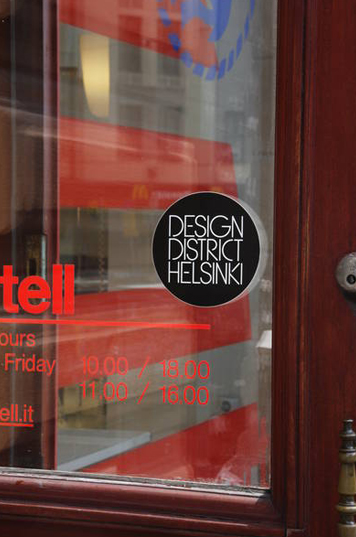
Helsinki Design District – The Helsinki Design District is a loose confederation of dozens of shops, galleries, and museums clustered west and south of the Esplanadi. Get your bearings at Design Forum Finland a fabulous shop and informational resource. Erottajankatu 7. +358 9 6220 8132 www.designforum.fi
Design Museum – An essential stop in the district, showcasing Finland’s design hallmarks and new works from the up and comers. Korkeavuorenkatu 23. www.designmuseum.fi
Ivana Helsinki – Fashionistas, Finland’s latest style sensation is your temple.
Uudenmaankatu 15. +358 50 505 1624. www.ivanahelsinki.com
Marimekko – The biggest of the 3 big players with 6 stores in Helsinki, this textiles and fashion firm loved across the world is dead-on identified as quintessentially Finnish. Pohjoisesplanadi 33. www.marimekko.fi
Artek – Design gurus, this is where it all began. Etelaesplanadi 18. +358 010 617 3480 www.artek.fi
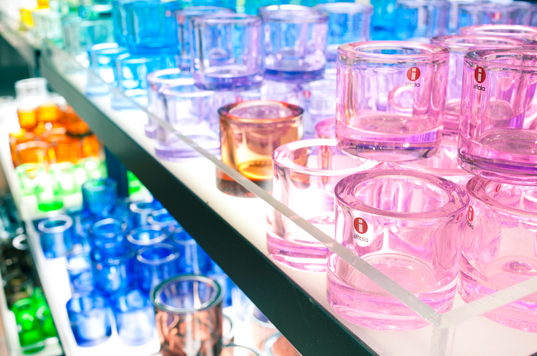
Iitala – Pick up the iconic Aalto vase that will forever change the way you think about fresh flowers. Pohjoisesplanadi 25. +358 020 439 3501
Stockmann – Would you go to New York City and not have a look in Macy’s? After a little shopping have lunch on the promenade behind the store. Open every day. Aleksanterinkatu 52. www.stockmann.fi
Lasipalatsi Film and Media Center – With its 1936 cruise liner aesthetic, this is a great place to hang with a drink, get your bearings and figure out what tram will get you back to your hotel. Now where is that map? Mannerheimintie 22-24. www.lasipalatsi.fi
Alvar Aalto House – Frozen in time and pristinely preserved (you’re given booties to cover your shoes), Alvar and Aino Aalto’s home and office, a modest 2 story structure finished in 1936, is a study in simplicity with unusual flourishes that dazzle the eye. Hourly tours from Feb. to Nov. (except Aug.) and closed Mondays. Riihitie 20. +358 09 481 350 www.alvaraalto.fi
Suomenlinna – A UNESCO World Heritage Site, this mid 1700’s fort on a storied island provides a crash course in Finnish history and the island is a beautiful spot to spend a sunny afternoon. Don’t miss the Toy Museum, an awesome private collection of practically every toy and doll ever made. www.suomenlinna.fi
Ateneum Art Museum– A great art museum for a great city, a reliquary where you can easily spend an entire day. The palatial Beaux Arts building houses everything from Finnish and Nordic artworks to precious van Goghs and Gauguins. Kaivokatu 2. +358 (0)9 6122 5510. www.ateneum.fi[/alert]

